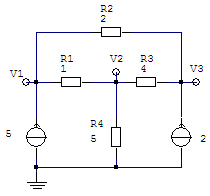

Nodal Analysis - KCL and MatlabA nodal analysis can be performed by examining each node in a circuit. The goal is to find out what the voltages are in each node with respect to our reference node. We need to know the currents flowing in the circuit and the resistances between each nodes. This is just an application of the Ohm's Law. Kirchhoff’s current law (KCL) states that for any electrical circuit, the algebraic sum of all the currents at any node in the circuit is zero. With one node selected as
node 0 (reference), there will be n-1
independent equations. If we assume
that the admittance between nodes i
and j is given as Yij, we can write the
following
equations including all of the nodes in the circuit:
m
= n - 1
Y
V = I And naturally, its
solution is: V
= Y -1I, which in Matlab can be easily solved
using the backslash
operator (\), like this: V
= Y\I The following example illustrates the use of Matlab for solving nodal voltages of electrical circuits. Nodal Analysis - find the voltages in a circuit
Using KCL, and forming our matrices Y and I, let’s see... For node V1
we
have, and the first row of our Y
matrix is going to be the coefficients for the voltages. This means
that we can form our matrix in Matlab like this Y(1,:) =
[(1/1 + 1/2) -1/1 -1/2]; At node V2,
the second row of our Y matrix is going to be the new set of coefficients for the voltages. Letting Matlab work out the operations, we express Y(2,:) =
[1/1 (-1/1 - 1/4 -
1/5) 1/4];
thus, our
third row of the Y matrix is Y(3,:) =
[-1/2 -1/4 (1/2 + 1/4)]; Summarizing our findings, we fill-in our matrices Y and I, like this: Y = 1.5
-1.00
-0.50 I = 5 The solution is easy using Matlab: just type V = Y\I. The answer is matrix V, with three rows (our vector of unknowns contains three variables in a column: V1, V2 and V3)
An analysis with more components From 'Nodal Analysis' to home From 'Nodal Analysis' to Matlab Programming
|







